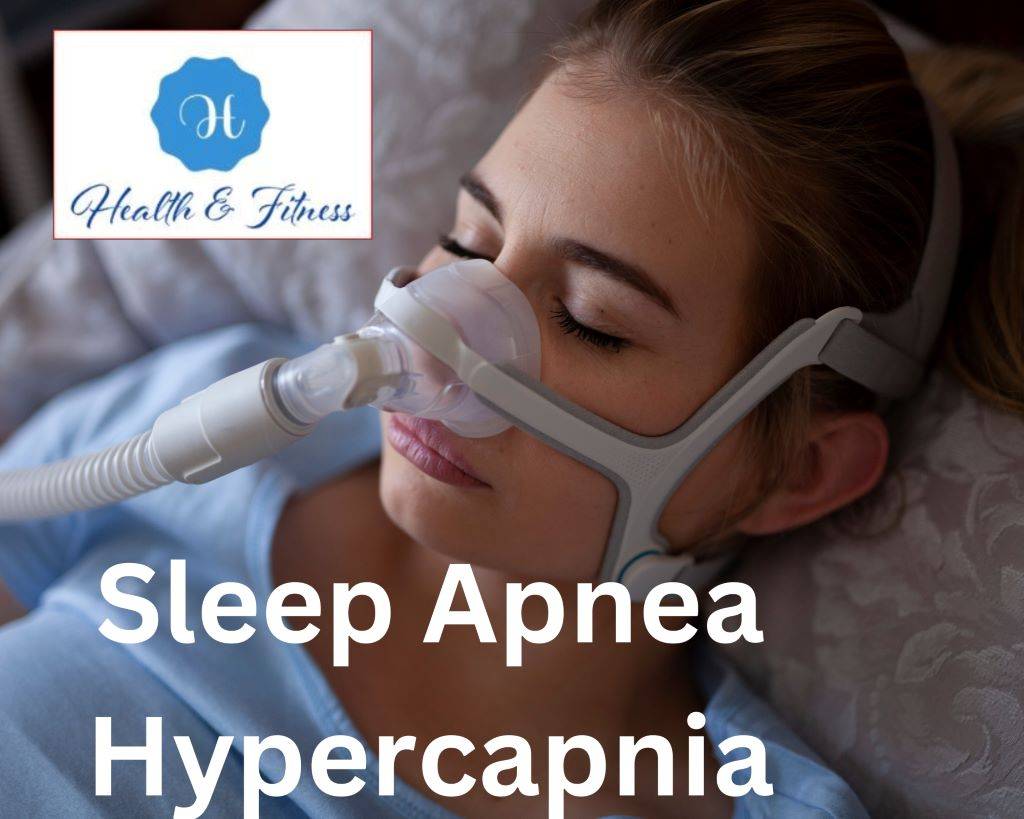The link between Hypercapnia and Sleep Apnea
Hypercapnia is a condition that occurs when there is an excess of carbon dioxide in the bloodstream. Sleep apnea is a sleep disorder that repeatedly causes breathing to stop and start during sleep. Hypercarbia and sleep apnea can raise body carbon dioxide levels, posing health risks. In this article, we will explore how sleep apnea can cause Carbon dioxide toxicity and the implications of this condition.
Sleep apnea can seriously affect a person’s sleep quality and quantity. Twenty-two million People may have sleep apnea, many of whom are unaware. Untreated apnea can cause hypertension, coronary heart disease, and stroke.
Sleep apnea can also induce CO2 retention. Hypercarbia and sleep apnea are linked, and this page will examine the symptoms. and causes of Hypercarbia, and the available treatment options for both conditions.
The Physiology of Sleep Apnea

Sleep apnea is a sleep disorder characterized by repeated breathing interruptions during sleep. Sleep apnea can be obstructive (OSA) or central (CSA).
1-OSA occurs
when the airway is partially or completely blocked during sleep, leading to decreased oxygen levels and increased carbon dioxide levels in the blood.
2- CSA
occurs when the brain fails to signal the muscles to breathe, leading to decreased oxygen and increased carbon dioxide levels. The breathing disruptions during apnea can lead to Hypercapnia because the body cannot effectively eliminate carbon dioxide. Carbon dioxide levels in the blood rise, and oxygen levels fall, causing a cascade of adverse health effects.
Sleep apnea can exacerbate Hypercapnia and increase the risk of complications in individuals with underlying lung disease. Hypercapnia is not a common sign of sleep apnea; it usually only happens to people with lung disease or other medical conditions.
However, it’s important to know how sleep apnea and hypercapnia are linked to manage and treat both conditions well. In the next section, we’ll discuss the signs and dangers of Hypercapnia in people with sleep apnea.
The Connection Between Hypercapnia and Sleep Apnea
Sleep apnea sufferers must be aware of the possibility of hypercapnia and seek medical assistance if symptoms occur.
1- of how Hypercapnia can occur in sleep apnea patients
During sleep apnea, a person’s breathing becomes shallow or stops altogether, which can cause a build-up of carbon dioxide in the body.
Usually, the body expels carbon dioxide through exhalation, but this process is interrupted during sleep apnea. As a result, the body’s carbon dioxide levels can increase, leading to Hypercapnia.
2- Symptoms of Hypercapnia in sleep apnea patients
The symptoms of Hypercapnia in sleep apnea patients may include:
Shortness of breath
Headaches
Fatigue
Confusion
Rapid heartbeat
Sweating
Flushed skin
These symptoms may be more pronounced during sleep or in the morning after waking up.
3- the potential risks of untreated Hypercapnia in sleep apnea patients
CO2 retention can cause health complications if left untreated, especially for individuals with underlying respiratory conditions like apnea.
High levels of carbon dioxide can make the blood lack oxygen, making breathing hard—a disease in which the lungs can’t give the body enough oxygen. Also, Hypercapnia can cause damage to the brain and other vital organs that lasts for a long time.
Diagnosis of Hypercapnia in Sleep Apnea Patients

Patients with sleep apnea are more likely to get Hypercarbia, and it is important to catch the condition early to avoid problems.
The diagnostic process for Hypercarbia in sleep apnea patients involves a combination of physical exams, medical history reviews, and specific tests.
1- The diagnostic process for Hypercapnia in sleep apnea patients
The healthcare provider will examine the patient’s respiratory rate, oxygen saturation level, and heart rate during a physical exam.
They will also review the patient’s medical history, including any previous diagnosis of sleep apnea, lung disease, or other medical conditions that may increase the risk of Hypercapnia.
2- tests used to diagnose Hypercapnia in sleep apnea patients
The tests used to diagnose Hypercarbia in sleep apnea patients may include:
1- In a test known as an arterial blood gas (ABG) analysis:
This procedure determines blood oxygenation and carbon dioxide levels. An ABG test may reveal high carbon dioxide levels in sleep apnea patients, indicating CO2 retention.
2- Pulmonary function test (PFT):
This test evaluates lung function and can identify any issues with gas exchange in the lungs. A PFT can help detect any underlying lung diseases contributing to Carbon dioxide retention.
3- Sleep study:
A sleep study, known as a polysomnogram, measures various body functions during sleep, including oxygen and carbon dioxide levels. A sleep study can detect apnea and associated complications, such as Carbon dioxide retention.
importance of early detection and diagnosis of Hypercapnia in sleep apnea patients
Early detection and diagnosis of Hypercapnia in sleep apnea patients are crucial in preventing further complications. Hypercarbia can cause respiratory failure, coma, and death if not treated.
Therefore, sleep apnea patients should undergo regular medical check-ups, including tests to monitor their carbon dioxide levels and lung function. Early detection and treatment of Hypercarbia can help prevent potentially life-threatening complications and improve sleep apnea patients’ overall quality of life.
Treating Hypercapnia in Sleep Apnea Patients
Sleep apnea is a severe condition that can lead to Hypercapnia if left untreated. Fortunately, several effective treatment options are available to manage Hypercarbia in sleep apnea patients.
1-Different treatment options for Hypercapnia in sleep apnea patients
Treating High CO2 levels in patients with sleep apnea typically involves addressing the underlying condition.
Standard sleep apnea treatments include:
Continuous Positive Airway Pressure (CPAP) Therapy: CPAP is the most common and successful apnea treatment. It involves using a machine that delivers continuous air pressure through a mask worn over the nose and mouth while sleeping. The air pressure helps to keep the airway open, preventing breathing disruptions and the resulting Hypercarbia.
Bi-Level Positive Airway Pressure (BiPAP) Therapy: BiPAP therapy is similar to CPAP therapy but provides two different levels of air pressure – one for inhalation and one for exhalation. This therapy is typically recommended for patients with more severe sleep apnea or who have difficulty tolerating CPAP therapy.
Oral Appliance Therapy: Oral appliance therapy involves wearing a custom-fitted device in the mouth during sleep to help keep the airway open. This option is typically recommended for patients with mild to moderate sleep apnea who cannot tolerate CPAP therapy.
Lifestyle Changes: In some cases, lifestyle changes such as weight loss, quitting smoking, and avoiding alcohol before bedtime may be recommended to help manage sleep apnea and reduce the risk of Hypercapnia.
Continuous positive airway pressure (CPAP) therapy

can be used to treat Hypercapnia in sleep apnea patients. CPAP therapy is considered the standard gold treatment for sleep apnea and can also effectively manage Carbon dioxide retention in sleep apnea patients.
The continuous air pressure delivered by the CPAP machine helps to keep the airway open, preventing breathing disruptions and ensuring proper gas exchange. This helps to normalize carbon dioxide levels in the body and prevent the development of Hypercarbia.
other treatment options for Hypercapnia in sleep apnea patients
In addition to CPAP therapy, other treatment options are available to manage High CO2 levels in sleep apnea patients. These include:
Oxygen Therapy: Oxygen therapy can increase oxygen levels in the body and reduce carbon dioxide levels. This treatment may be recommended in severe cases of Hypercarbia.
Mechanical Ventilation: In some cases, mechanical ventilation may be necessary to manage severe High CO2 levels in apnea patients. This involves using a machine to assist with breathing and ensure proper gas exchange.
Medications: In rare cases, drugs such as bronchodilators or diuretics may be prescribed to manage Hypercarbia in sleep apnea patients.
Sleep apnea patients must collaborate with their doctors to find the best treatment. Sleep apnea care prevents hypercapnia and improves health and enjoyment of life.
Lifestyle Changes to Prevent Hypercapnia in Sleep Apnea Patients
Lifestyle changes can effectively prevent and manage Hypercapnia in sleep apnea patients. In this section, we will discuss some lifestyle changes that can be made to prevent Hypercarbia in sleep apnea patients.
Lifestyle changes that can be made to prevent Hypercapnia in sleep apnea patients
Maintain a healthy weight: One of the most effective lifestyle changes that can be made to prevent Hypercarbia in sleep apnea patients is maintaining a healthy weight. Obesity is a significant risk factor for sleep apnea and can lead to the development of Hypercarbia. Losing weight through diet and exercise can significantly reduce the risk of developing Obstructive Sleep Apnea patients.
Regular exercise can also help prevent Obstructive Sleep Apnea in patients. Exercise can improve lung function and respiratory muscle strength, which can help prevent the development of Hypercarbia. Aerobic exercise, in particular, can be beneficial for sleep apnea patients.
Quit smoking
Smoking is a major risk factor for sleep apnea and hypercarbia. Stopping smoking can lower Hypercarbia risk and enhance health.
Weight management and exercise in preventing Hypercapnia in sleep apnea patients
Weight management and exercise are crucial for preventing Obstructive Sleep Apnea patients. Obesity is a significant risk factor for sleep apnea and can lead to the development of Hypercarbia. Maintaining a healthy weight through diet and exercise can significantly reduce the risk of developing Hypercarbia in sleep apnea patients.
Regular exercise can also help prevent Hypercarbia by improving lung function and respiratory muscle strength. Aerobic exercise, in particular, can benefit apnea patients as it can improve oxygenation and reduce the risk of developing Hypercarbia.
Role of smoking cessation in Preventing Hypercapnia in sleep apnea patients
Smoking increases the likelihood that a person with sleep apnea may also develop Hypercarbia. Respiratory problems can be made worse by smoking. lung illness, and worsening existing symptoms.
Quitting smoking can help reduce the risk of developing Hypercapnia and improve overall health. It is essential for sleep apnea patients who smoke to stop as soon as possible to reduce the risk of developing Hypercarbia and other respiratory complications.
So, lifestyle changes can effectively prevent and manage Hypercarbia in sleep apnea patients. Maintaining a healthy weight through diet and exercise, regular exercise, and quitting smoking are all significant lifestyle changes that can help prevent Carbon dioxide toxicity and improve overall health in sleep apnea patients.
Conclusion
Sleep apnea is linked to Hypercarbia. Sleep apnea, a frequent disorder that disrupts breathing during sleep, can raise blood carbon dioxide levels. If untreated, Hypercarbia can induce shortness of breath, headaches, confusion, and respiratory failure. Sleep apnea patients should know about High CO2 levels and their hazards. Treating Hypercarbia early can avert more serious problems.
Finally
apnea sufferers can prevent High CO2 levels by losing weight, exercising, and stopping smoking. Sleep apnea patients can also avoid Hypercarbia with CPAP. patients must see their doctor regularly and report Carbon dioxide toxicity symptoms. Sleep apnea patients can enhance their health and quality of life by managing and preventing Hypercarbia.



